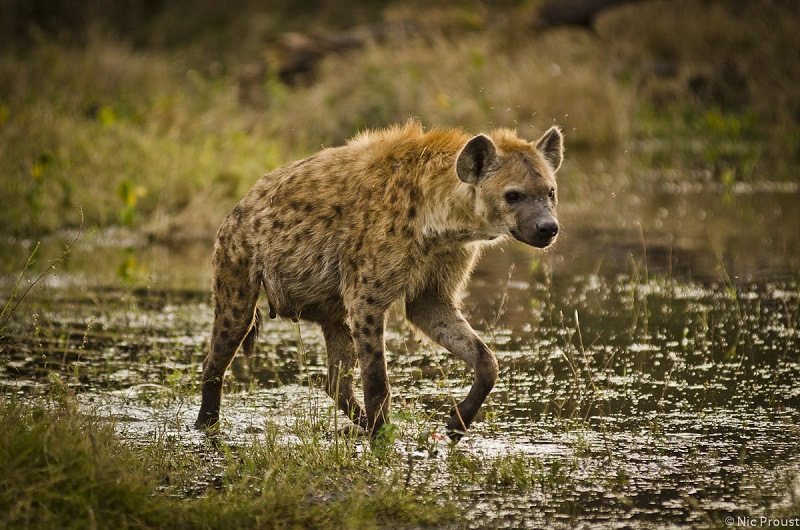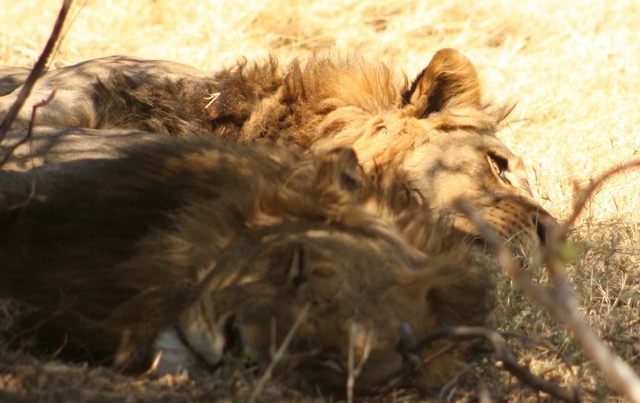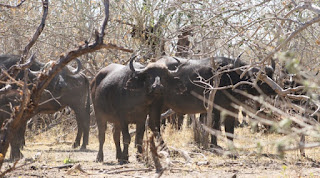We finish breakfast, helped by our young chefs who were always keen to get involved with the cooking, as Jo was a great cook herself ............. and could even rustle up a full 3 coarse supper for 10 within the hour on the several occasions back in England, when we could often get home, from a day out, after our supper guests had already arrived! ..................... nothing like last minute! ............. but, her skills had clearly been passed on to the children and they enjoyed mucking in and there is always a sense of fun and wild spirit cooking food over an open fire, especially when you never know who is looking in through the bush and might want to invite themselves around! With breakfast finished, we clear up and start to pack the Land Rover, but when taking our tent down I notice a small steel blue wasp dancing around at the base of the tree and taking a closer look I can see a huge Huntsman Spider sitting snug in the tree roots.
The spider was huge, brown and hairy, the size of the palm of my hand and this thin 'fly like' wasp was tiny in comparison, but a bright steel blue in colour, which is what drew me to notice it. At first I thought the spider was attacking the wasp, but couldn't understand why the wasp didn't simply fly away to safety. I called the children over to watch and it became apparent that the wasp was trying to attack this huge spider, forcing it to leap up and down, in defense, from its shallow position nestled in the roots. It was a real David and Goliath situation and seemed like a loosing battle for the wasp, simply due to the size of the spider.
We continued to watch in awe as this small bright blue wasp danced around the spider with great care and agility, trying to strike a quick toxic blow, from the wasps abdomen, without being caught in the clasp of the spiders legs, which would undoubtedly mean sudden death to the wasp. The wasp jumped and danced and flew around the spider, who was by no means slow in trying to catch the wasp and with significant speed the wasp would hit the spider with its toxic sting.
We carried on watching as the wasp kept a close eye on the spider and the spider suddenly became limp and incapacitated, it was quite amazing to see. This tiny wasp then cautiously approached the spider and grabbed hold of the spiders legs, clasping a leg in its jaws and proceeded to drag the spider, from its small burrow. It then did something quite amazing and dragged this huge hairy body, vertically up the trunk of the tree, some 3 metres in height. How such a small, thin wasp could pull up such a heavy weight of a dead weight spider was unbelievable and not only pull it, but pull it vertically up a tree.
The wasp dragged it up the trunk and along a branch into a crevice in the tree. We found out that the wasp was a 'spider hunting wasp' ( Batozonellus fuliginosus sepulchralis - to be precise. It normally hunts the Orb Web Spider, but this one had bigger aspirations taking on the Huntsman Spider!) and the wasps sting is extremely toxic and affects the spiders nervous system, by paralyzing the spider but not killing it. The spider is too heavy to carry in flight so the wasp must drag it to its nest. Now for the gruesome bit! - The wasp lays its egg on the paralyzed spider and buries the spider in its nest, still alive! and the wasp egg hatches within 10 days and starts to feed of the body of the 'still alive', but paralyzed spider!! ................... so having finished the visual lesson of the morning with the children on 'Natural Horror movies' ................... the 'Freddy Krueger' of the African Wasp world, which, although horrific, was a pretty awesome thing to have visually experienced, we finished packing the tent and headed out.
 |
| Fourth Bridge - or what was left of it! |
There were several routes out of Third Bridge and we take the longest route, winding our way back over to Fourth Bridge and then picking up a good road to South Gate. Here the children can fill in the board at the Gate Office of all the animals they have seen.

On the way over to Fourth Bridge we again, come across the Hippo family having fun in the shallows. There are about 7 of them with some youngsters and what appear to be a couple of teenagers who are again, play fighting in the water. We pull off the tack to watch them and realize that the play fighting seems to be getting a little rough and aggressive, as the two large beasts clash heads and jaws, with grunting blows and water splashing everywhere! We all get out of the Land Rover to take a closer look ........ it seems to be another game of 'who has the biggest mouth!' .......... and trust me a Hippo's mouth is by no means small. ...................... in 2005, whilst privileged to have worked in the previously mentioned rehabilitation clinic in South Africa I had the bizarre experience of feeding a fully grown Hippo, with jaws wide open, a bin full of food, on the back of a pick-up truck whilst being chased by a wild Rhino! ......... still can't believe that actually happened! The Hippo had been raised as a calf, but now fully grown had been released back into the wild. .... However, as it had only recently been released it was still dependent on being fed regularly by the rangers, until it got used to its new surroundings, but to complicate matters, the Hippo had recently befriended a wild Rhino! .... So, the rangers went through the plan: I sit on the back of the pick-up, with another student, with the bin full of food ........... we head out and find the Hippo. When we find the Hippo, we stop the truck, I drop the back section of the truck down, the Hippo will run towards the truck, knowing it is going to be fed. ................ The Hippo will mount the the back of the truck with its front legs, open its mouth wide open ............ and I then have about 30 seconds to pour the bin of food into the Hippos huge open mouth before the wild Rhino catches up. .................... GOT IT! .............. sounded simple!
We drove out into the bush in search of the Hippo, who tended to stay in the same location. As the truck was searching for the Hippo, one of the rangers in the passenger seat shouted: 'I see the Hippo ............ she's seen us'. With that, the truck stopped ............. I looked up and could see this full grown Hippo 'bounding' towards the truck, ....... this dark brown, overweight giant with short stubby legs, sprinting towards the pick-up! .............. it all seemed a bit surreal ............ I quickly dropped the back hatch of the truck and grabbed the bin of food, slowly and subconsciously backing away, as the Hippo got closer and seemed to be getting somehow larger! ................ The Hippo thundered down to the truck, mounted the back up the vehicle with its front legs, like a circus animal ............ the suspension dropped to the floor carrying the weight of the Hippo and this huge gaping mouth opened wide and waited for its feed! ............... 'Quick, ... feed the Hippo, ............ the Rhino's coming!' ..... shouted the driver ............... I looked up and could see this wild Rhino come bounding round the bend of the track, dust flying up from its feet, in hot pursuit of his friend, the Hippo ................ it was about 60 metres away and moving fast. ................... I rushed to the gaping mouth of the Hippo and poured the whole bin of feed into this expectant mouth as quickly as possible, shouting to the driver ........... 'it's in .......... GO, GO!' ................. just before the Rhino arrived the pick-up sped forward, the Hippo dropping to the floor, the suspension springing back into action and we shot off, luckily avoiding a full on ramming speed approach from the Rhino! ...................... I sat back in the truck, with a huge smile on my face, probably the most comical and surreal moment of my life! - ............... 'did that really just happen!?'
Leaving the Hippo's to finish their spat, we get back in the Landy and carry on, down a particularly slow, dusty and bumpy track, this is supposed to improve after 15 km, but doesn't really get any better and it is a slow drive to South Gate where we need to sign out. A quick loo stop and a coffee break and we head for Maun along another gravel road with huge pot holes that mean driving is again slow. The last 25km are on tarmac road which is a very nice change!
Our resting point today is Thamalakane River Lodge, where we have booked a two bed chalet for us all to squeeze in, giving us a break from the Camping and allowing us to take a good shower and refresh ourselves before heading out again. The lodge is very pleasant and sits on the banks of the Thamalakane River and lies about 19km from Maun, on the edge of the Okavango Delta. It has a large restaurant and small pool and is a quick stop to re-charge the batteries. We have a bit of lunch and decide to head out on a boat trip along the river at 4.30pm, which was not quite what we expected and is a little touristy and not a great deal to see, but we do manage to see few African Jacana birds wading on the water lilies and a very beautiful Angolan Reed Frog .............. very colourful and not poisonous!


 |
| Angola Reed Frog |
 |
| African Jacana Wader |
 |
| Sunset on Thamalakane River |
After the boat trip, we quickly freshen up and head to the restaurant for supper, .......... a nice change from cooking over the fire and having to make sure the children are always in bed early. The food is very good but the waitress gets a little confused on the order and dishes up two 12oz rib eye steaks to Harry and Jo, enough to keep them going for at least a week! Still, ........ fed and watered, we enjoy the meal, reflecting on our trip over the last week and turn in for a good nights sleep, after watching another wonderful African sunset - something that will definitely be missed.
After a good breakfast, Jo and the children pack the Land Rover, while I am trying to load photos on the blog, but as usual it takes a bit of time as African internet is pretty useless at the best of times. It is amazing that in South East Asia, a great internet connection was available in every remote part we visited, but in Africa it was hopeless and took and age to get anything downloaded, so we don't end up leaving until about 11.00am.
We reach the town of Maun, which is the fifth largest town in Botswana and known as the 'tourism capital' of Botswana, with a population of about 57,000 people, being the gateway to the Okavango Delta. This was a good stop for us to finally get haircuts, stock up on food, water and fuel and also pick up a new sim card for Jo's phone, as with poor internet connection we are struggling to find somewhere to stay for the last 10 days of our trip. When we finally finish our adventure, the children will go straight back to school, ............... literally, with one days gap, which is likely to be a real shock to the system, so we have decided that the last 10 days need to be somewhere where we can simply completely chill out and do nothing except relax and reflect on the incredible journey we had all been on. This would hopefully help both the children and us come back down to the reality of normal life. It would be difficult, especially for the children being so young but we are hopeful that the education they have experienced over the last 6 months would far outweigh anything they would have learnt at school.
We finish stocking up on supplies and it is about 3.30pm before we leave Maun. We are heading for the Nai Pan National Park and Jo takes a stint at driving whilst I am still trying to get a decent internet connection to load photos on the blog, although I end up spending time on the phone trying to get reception to resolve a few minor issues back at work! I have been very lucky to be able to take a 'self employed' sabbatical over this period with the ability to completely switch off which has been great.
We are now on a tarmac road, which is a very unusual feeling, as most of our driving has been on either deep sand, pot holed gravel or dusty or corrugated tracks, so a bit of speed is quite encouraging and we make good time, travelling the 190km to the Park 'vets' control check point (for foot and mouth), which we reach at about 5.00pm and where we even have to take out our spare shoes to dip into the foot bath, which the children find very amusing. From the check point we still have 40km to travel to the South Camp and ....... yes ...... back through deep sand, so I find myself letting air out of the tyres to make the journey easier.

Travelling through the Nai Pan National Park, we see different animals than we had seen at Moremi and Chobe, the children getting their best spotting eyes in focus to spot Oryx, which I believe are one of the most beautiful animals in the bush. The Oryx, or Gemsbok has the amazing ability to survive in dry arid central regions of the Kalahari without the need for drinking water, getting all of its moisture requirements from the leaves and melon it eats and has an a pair of very long and sharp horns for protection which have been known to impale the odd lion! We also spot Springbok and even a couple of Ostrich on the way and manage to accidentally get unnervingly close to a large elephant who seems to be at home at our camping pitch, where we (and him!) are the only residents. ......... There might be a bit of competition walking to the ablutions block at night! ..........................











































